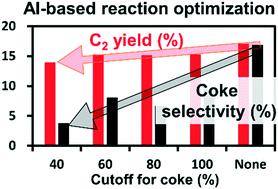当前位置:
X-MOL 学术
›
React. Chem. Eng.
›
论文详情
Our official English website, www.x-mol.net, welcomes your feedback! (Note: you will need to create a separate account there.)
Reaction condition optimization for non-oxidative conversion of methane using artificial intelligence
Reaction Chemistry & Engineering ( IF 3.9 ) Pub Date : 2020-12-16 , DOI: 10.1039/d0re00378f Hyun Woo Kim 1, 2, 3, 4 , Sung Woo Lee 3, 4, 5, 6 , Gyoung S. Na 1, 2, 3, 4 , Seung Ju Han 3, 4, 5, 6 , Seok Ki Kim 3, 4, 5, 6, 7 , Jung Ho Shin 1, 2, 3, 4 , Hyunju Chang 1, 2, 3, 4 , Yong Tae Kim 3, 4, 5, 6
Reaction Chemistry & Engineering ( IF 3.9 ) Pub Date : 2020-12-16 , DOI: 10.1039/d0re00378f Hyun Woo Kim 1, 2, 3, 4 , Sung Woo Lee 3, 4, 5, 6 , Gyoung S. Na 1, 2, 3, 4 , Seung Ju Han 3, 4, 5, 6 , Seok Ki Kim 3, 4, 5, 6, 7 , Jung Ho Shin 1, 2, 3, 4 , Hyunju Chang 1, 2, 3, 4 , Yong Tae Kim 3, 4, 5, 6
Affiliation

|
Chemical reactions typically have numerous controllable factors that need to be optimized to yield the desired products. Although traditional experimental methods are limited to explore possible combinations of these factors, artificial intelligence (AI) can provide the optimal solution based on chemical reaction data. In this study, we optimize the non-oxidative conversion of methane to C2 compounds using AI, such as machine learning (ML) to predict experimental results and metaheuristics to optimize the reaction conditions. A decision tree-based machine learning method can reasonably predict the reaction outcomes (CH4 conversion, C2 yield, and selectivities for C2 and coke) with an error of <5%. Trained ML models are applied to maximize the C2 yield by optimizing the reaction parameters with metaheuristics. We can simultaneously enhance the C2 yield and suppress the coke formation by improving the multi-objective function for the optimization. We believe that our method will be helpful to optimize the chemical reaction conditions with multiple targets.
中文翻译:

利用人工智能优化甲烷非氧化转化反应条件
化学反应通常具有许多可控因素,需要对其进行优化以产生所需的产物。尽管传统的实验方法仅限于探索这些因素的可能组合,但人工智能(AI)可以根据化学反应数据提供最佳解决方案。在这项研究中,我们使用AI优化了甲烷到C 2化合物的非氧化转化,例如机器学习(ML)来预测实验结果和元启发法来优化反应条件。基于决策树的机器学习方法可以合理地预测反应结果(CH 4转化,C 2产率和对C 2的选择性和焦炭),误差小于5%。通过使用元启发式算法优化反应参数,可以使用经过训练的ML模型来最大化C 2产率。通过改进优化的多目标函数,我们可以同时提高C 2收率并抑制焦炭形成。我们相信我们的方法将有助于优化具有多个目标的化学反应条件。
更新日期:2021-01-13
中文翻译:

利用人工智能优化甲烷非氧化转化反应条件
化学反应通常具有许多可控因素,需要对其进行优化以产生所需的产物。尽管传统的实验方法仅限于探索这些因素的可能组合,但人工智能(AI)可以根据化学反应数据提供最佳解决方案。在这项研究中,我们使用AI优化了甲烷到C 2化合物的非氧化转化,例如机器学习(ML)来预测实验结果和元启发法来优化反应条件。基于决策树的机器学习方法可以合理地预测反应结果(CH 4转化,C 2产率和对C 2的选择性和焦炭),误差小于5%。通过使用元启发式算法优化反应参数,可以使用经过训练的ML模型来最大化C 2产率。通过改进优化的多目标函数,我们可以同时提高C 2收率并抑制焦炭形成。我们相信我们的方法将有助于优化具有多个目标的化学反应条件。



























 京公网安备 11010802027423号
京公网安备 11010802027423号